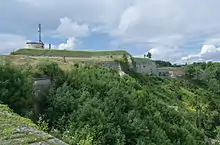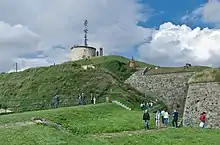Kłodzko Fortress
Kłodzko Fortress (Polish: Twierdza Kłodzko, German: Festung Glatz) is a unique fortification complex of the Lower Silesian Voivodeship in southwestern Poland. The fortress once was one of the biggest strongholds in Prussian Silesia, however, in the whole German Empire, it was regarded as a minor one.[1] Now, together with an extensive network of tunnels, it is one of the biggest attractions of the town of Kłodzko, with its underground labyrinth and a repository of different objects, from old fire engines to local glassware.[2]


History
A stronghold on Kłodzko's Castle Hill was mentioned for the first time in the Chronicle of Bohemians, written by Cosmas of Prague. Most probably, it was a complex of wooden buildings, protected with a palisade. Kłodzko itself is located along the strategic route between Wrocław and Prague, and its role as a trading point must have been significant since the early Middle Ages. In 1114, the stronghold was captured and destroyed by Bohemian troops under prince Soběslav, who at the same time reconquered the whole area.
In 1129, Soběslav rebuilt the town and placed a castellan there. Some time around 1300, a spacious castle was built on the hill, which became seat of the Kłodzko County. Gradually, the castle grew, a church and a chapel were added and in 1557, Lorenz Krischke, architect at the court of Prince Ernest of Bavaria, built the Lower Castle.[3] In the 16th century, there were five wells in the castle with the oldest one from 1393.
In 1622, during the Thirty Years' War, after the long siege, the fortress was captured by the Austrian Army. The city was besieged in June of that year, but for a long time resisted the attackers. Finally, the Austrians brought in two large cannons - the Wingless Dragon and the Black Sow to fire upon the walls of Kłodzko and the city surrendered on October 25.[4] In subsequent years the Austrians modernized the fortress and replaced ancient fortifications with up-to-date bastions.
In 1742, during the War of the Austrian Succession the city together with its stronghold was conquered by Prussia under Frederick II. The city itself surrendered on January 14, but the fortress, with 2000 soldiers, held out until April 25, when starvation made further resistance impossible. Out of the initial Austrian garrison of 2000, only 200 survived, "pale as shadows".[5] The Prussians expanded the fortress, making it a defensive one. Major works continued during the Silesian Wars, until 1770, however, the fortress was not fully completed 200 years after the Austrians began to modernize it.[6]
in 1745 by Friedrich II order at Glatz under the guard of Heinrich August de la Motte Fouqué was imprisoned a Prussian officer Friedrich von der Trenck. Next year he escaped from the fortress.
In the 19th century, the stronghold, which in 1807 was captured by the French Army supported by Bavarian troops[7] became a prison. In early 19th century, due to economic depression, prisoners' earnings in Glatz were so low that the administration would send a prisoner every Saturday to beg for help in the city.[8] Among prisoners there, was a British Army captain Bertrand Stewart, who in 1911 was accused of espionage and released in 1913.[9] During World War II, the stronghold was not only a prisoner-of-war camp, but a sub-camp of the Gross-Rosen concentration camp.[10]
Currently
In 1945, the stronghold together with the city became part of Poland. The Kłodzko Fortress, its current name, looks like it did 200 years ago with little changes, and it is one of the main tourist attractions of the city.[11] Between May and October, it is open from 9:00 to 19:00 and in the winter, it is open from 9:00 to 16:00. From its top, there are views of the Kłodzko Valley. It is also possible to visit the cellars, with a labyrinth of underground corridors, excavated in the 19th century by prisoners of war.
The stronghold's complex covers an area of 17 hectares. Its lower walls are 11 meters thick, and the upper walls are around four meters. According to some sources, it is the largest and the best preserved fortress of its kind in Poland.[12][13]
References
- German fortresses
- The Rough Guide, Poland, page 566
- Anzeiger für Kunde der deutschen Vorzeit: Organ des germanischen Museums, page 78
- Family Trees, The Sanftlebens
- History of Friedrich the Second, page 405
- "Kłodzko - Hillside Charm". Archived from the original on 2013-10-19. Retrieved 2008-09-08.
- Napoleon's German Allies
- Tales from the German Underworld, page 30
- Captain Bertrand Stewart, Queen's own West Kent Yeomanry Archived 2018-07-23 at the Wayback Machine.
- "Tourism in Lower Silesia:Klodzko". Archived from the original on 2012-02-16. Retrieved 2008-09-08.
- Ancient Kłodzko
- "Kłodzko - Hillside Charm". Archived from the original on 2013-10-19. Retrieved 2008-09-08.
- "Silesia's Treasures". Archived from the original on 2008-09-19. Retrieved 2008-09-08.
External links
- Photo gallery of the fortress Archived 2022-01-28 at the Wayback Machine
- Panorama of the fortress
